Crawler crane market is setting the stage for steady growth
17 July 2023
Many factors are driving the lattice boom crawler crane market, including a steady stream of infrastructure projects throughout North America. The market for crawler cranes, often considered the standard-bearer in the realm of cranes, is trending in a positive direction.
Jim Jatho, crawler cranes product manager, Liebherr USA, said the crawler market is evolving, and demand is increasing.
“For North America we clearly saw 2022 as a transition year with all the global challenges going on, therefore less demand,” said Jatho. “However, for 2023 and 2024, we see an increase in demand in North America, driven by infrastructure and wind (on- and offshore). Globally, the demand is on a stable level, which is good news, considering the challenges we are facing,”
Florian Ritzler, sales manager crawler cranes, Liebherr-Werk Ehingen, said managing supply chains has been a challenge, as well as the rising cost of steel.
“A recent challenge is the availability of shipping space on vessels,” Ritzler said. “It is a global problem which effects not only the crane manufacturers, but all industries.”
Despite challenges the overall market in the United States is steady and expected to remain that way through 2023.
“Overall, the outlook for the lattice boom crawler crane market is positive, and we expect steady growth over the next few years,” said Brian Elkins, lattice crawler and telescopic crawler product manager, Link-Belt. “Several factors contributing to this growth include the infrastructure bill, renewable energy, water treatment and of course oil and gas.”
Allen Kadow, manager, lattice boom crawler cranes, Tadano America, reports a consistent demand for large lattice boom crawlers in the North American market. Demand is primarily driven by new wind farm development and maintenance, as well as concrete tilt wall construction, he said.
“As the world continues to return to some level of normalcy, we are still experiencing delays in component procurement and we struggle with finding consistent vessel availability,” Kadow said. “Additionally, given the price of oil, we would typically see a higher demand for lattice crawlers in the petrochemical industry.”
In a one word summation, Kevin Blaney, vice president, crawler crane sales, Manitowoc Cranes, termed the market as “busy.”
“After the uncertainty of mid-2020, we have seen three years of consistently growing demand,” Blaney said.
Road and bridge construction projects are increasing, and precast panel and steel construction are consistent, according to Nichole Greco, senior product marketing manager, Sany America.
“One common theme is everything is getting bigger, from windmills to precast panels,” Greco said.
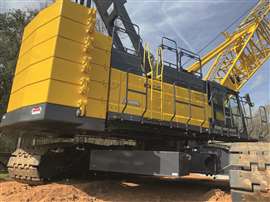 Kobelco CK2000G-3
Kobelco CK2000G-3
Bridging the gap
Like the other OEMs, getting product out the door and into customers’ yards is sometimes challenging.
“We are dealing with issues in maintaining a consistent flow of goods through the supply chains,” said Greg Ballweg, general manager, Kobelco Cranes North America.
Uncertainty regarding the overall U.S. economy is another significant factor.
“Interest rates are rising, and some companies are delaying bigger purchases hoping rates will go down,” said Sany’s Greco. “Next year is an election year so that can create uncertainty for long term projects.”
Link-Belt’s Elkins mentioned an increasing focus on transport and logistics costs, in addition to increasing freight costs.
“Short-term projects are seeing significant cost increases due to freight alone,” Elkins said. “Another challenge is meeting increased demand while also ramping up production.”
Elkins said space and jobsite mobility are an issue for crawler cranes.
“Lattice crawler cranes typically have larger footprints, and this makes their self-assembly feature a real plus to buyers,” he explained.
Manitowoc’s Blaney said that as an industry, aligning crawler manufacturing with actual demand and determining the magnitude of that gap is a challenge.
“It’s crucial to determine where the actual demand is,” he said.
The future is bright
Earlier this year, Kobelco launched its new repowered “G-3 Series” of crawler cranes. The new models have received very positive feedback, Ballweg said. “Dealers and end-user customers alike that we spoke to at the recent ConExpo were very optimistic about the crane work and opportunities for the upcoming year,” said Ballweg.
Kobelco’s best selling crane is the 110-ton CK1100G-3, because of its versatility in a wide variety of applications and its ability to transport with the track frames installed and be jobsite ready quickly, Ballweg said. Kobelco’s larger capacity crawler cranes are also seeing increased demand. Kobelco’s crawler crane product line features eight cranes, ranging from the 80-ton CK800G-3 up to the 330 ton CK3300G-2.
The recently repowered G-3 series features all new Isuzu Tier 4 engines with the energy/fuel saving “G-Modes” for operator selection to reduce fuel consumption.
“Our hydraulic over hydraulic control system is the long-standing highlight of Kobelco cranes and ensures the cranes maintain smooth and reliable operation in a wide variety of applications,” Ballweg said.
Improving safety
Liebherr-Werk Ehingen provides a wide portfolio of lattice type crawler cranes from 500 to 3,000 metric tons for all applications including wind installation and maintenance, port and refinery handling, bridge stadium building and offshore handling.
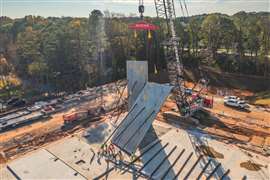 Liebherr LR 1400 SX
Liebherr LR 1400 SX
According to Liebherr, the 330-ton LR 1300.1 SX is the most “in demand” crane with orders well into 2024. The company is also seeing a growing interest in Liebherr’s electric/battery powered machines.
A new feature available now for all LR crawlers is a 1/2/3-degree barge chart LMI/LML which warns the operator acoustically as well as visually if either the pre-set inclination is reached or if the machine reaches the corresponding maximum capacity.
“This improves safety and takes the rather unsafe ‘paper-barge-charts guesswork’ out of the equation and is thus very well received by operators and safety personnel,” said Wolfgang Herzog, vice president, sales, Southeast and Caribbean, Liebherr USA. “We also just introduced a pile tilting device/fleeting block arrangement for the LR 1300.1 SX and LR 1400 SX to manipulate very long piles up to a maximum weight of 90 tons/198,500 pounds.”
Balance and versatility
In 2023, Link-Belt has seen a good blend of demand in both the 100-ton class with the launch of the new 110-ton 218|V, as well as their 200 to 300-ton class crawlers.
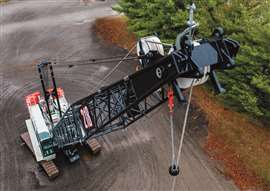 Link-Belt 218|V
Link-Belt 218|V
“In the 200 to 300 ton class, the 248 HSL, 298 Series 2 and 348 Series 2 are used for a wide range of projects, including infrastructure construction, building construction and industrial applications, according to Elkins.
“These cranes offer a balance of lifting capacity and mobility, making them versatile for various job site requirements,” said Elkins. “Our combo-type style design on the 298 Series 2 and 348 Series 2 have led to efficiencies in going back and forth between luffing and non-luffing applications.”
Link-Belt’s lattice boom crawler cranes range in capacity from 80 to 300 tons (138 HSL – 348 Series 2) with maximum main boom lengths from 40 feet to 355 feet (plus luffing attachments).
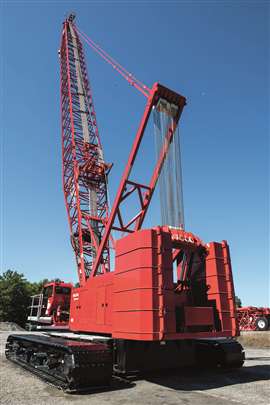 Manitowoc MLC250
Manitowoc MLC250
“In terms of sustainability, we have partnered with our engine supplier to offer alternative fuel options for our lattice boom crawler cranes such as HVO (Hydrotreated Vegetable Oil), which reduces emissions and make the machine more environmentally friendly,” said Elkins.
Link-Belt has incorporated a range of new environmentally friendly features into its lattice boom crawler crane product line, such as auto-idle/auto-stop, which reduces fuel consumption during a standby operation.
“Link-Belt recently unveiled a new electric Auxiliary Power Unit (APU), which allows for continued use of cab HVAC systems with the engine turned off, Elkins said.
Building out the range
Manitowoc takes pride in its full product line of lattice boom crawlers that range from 100 metric tons to 650 metric tons, Blaney said.
After the success on the larger side of the line-up with the MLC300 and MLC650, Manitowoc has spent the last few years focused on the smaller capacity cranes with the introduction of the MLC100, MLC150 and the MLC250, which are starting deliveries this summer.
“The engineering team at Manitowoc did a fantastic job moving from the highly engineered and advanced designs on the MLC300 and MLC650 to the smaller cranes which require a different design mindset focused on transportability, quick assembly and access to maintenance points,” said Blaney.
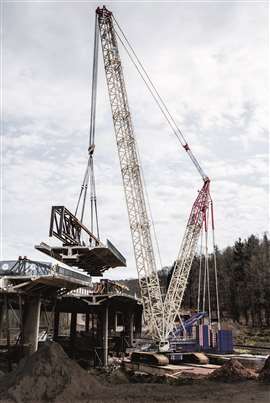 Tadano CC 38.650-1
Tadano CC 38.650-1
Design optimization
Tadano America continues to see the highest demand in its 300-metric ton class of lattice boom crawlers, according to Kadow. Tadano’s product offering consists of lattice crawlers from 400 to 3,200-metric tons.
“Our cranes feature many configurations including fixed jib, luffing jib, vessel lift jib, Super Lift auxiliary counterweight system with Vario Teleconnection, Flex Frame, split tray, Boom Booster heavy boom inserts, IC-1 control system, IC-1 Remote telematics and charts for increased wind speeds,” Kadow said.
In the fall of 2022, Tadano launched a Boom Booster kit for the CC 68.1250-1 model.
“The Boom Booster increases the lifting capacity of what is already a powerful crane by up to 30 percent,” said Kadow. “The kit not only increases the maximum hook height from 180 to 194 meters, but also the maximum load weight from 98 to more than 100 metric tons. This means that the CC 68.1250-1 can erect wind turbines with hub heights of up to 185 meters.”
Bigger brother
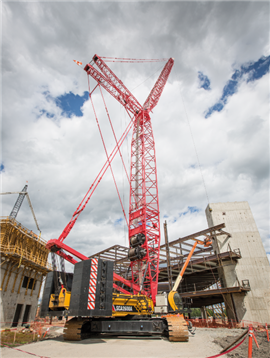 Sany SCA4000A
Sany SCA4000A
Sany launched the 440-ton capacity SCA4000A in late 2022. This crane is the big brother to the SCA2600A and is ideal for wind farm maintenance, refinery and petrochemical plants, precast concrete panels, port cargo handling and general construction work where reach and capacity are critical, Greco said.
Sany offers a full range of lattice boom crawler cranes from the 110-ton SCA1000A to the 400-ton SCA4000A.
Sany crawler cranes offer safety features such as a third wrap indicator, full-length boom walkways, seat interlock, virtual wall and harness tie-offs. Work light and cameras packages come standard, providing the operator with views of all winches and the area surrounding the crane. All Sany cranes are equipped with Tier 1 components including Cummins engines and are backed with a warranty of 3-years 3,000 hours. The 150 to 300-ton class cranes are the most sought after cranes in the Sany lineup.
EDITOR’S NOTE
American Cranes & Transport asked each crawler crane manufacturer to choose one model to feature in this article. Shown are the models they chose to highlight.
STAY CONNECTED


Receive the information you need when you need it through our world-leading magazines, newsletters and daily briefings.




